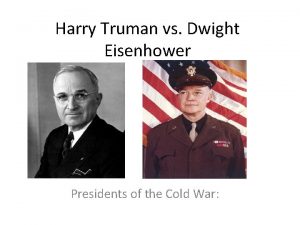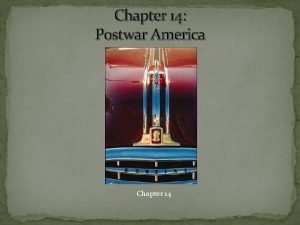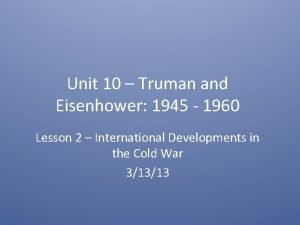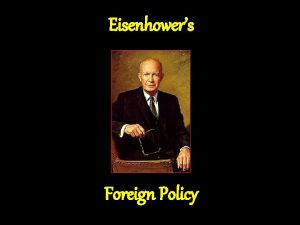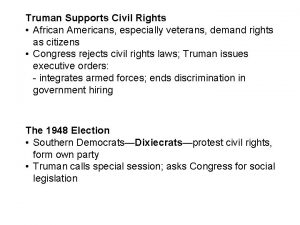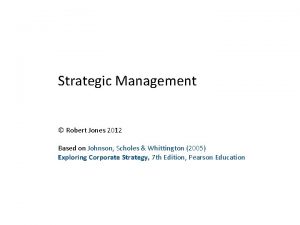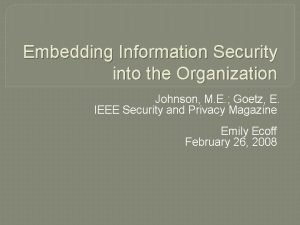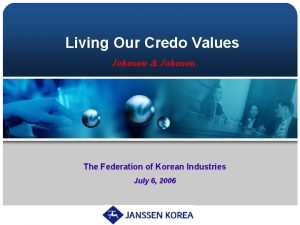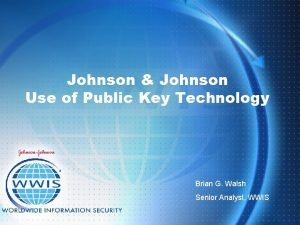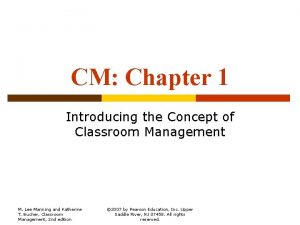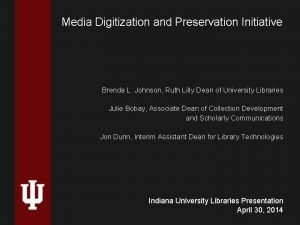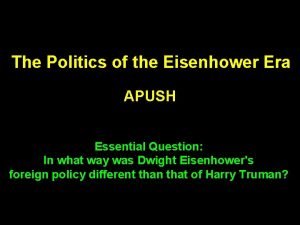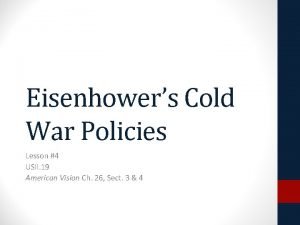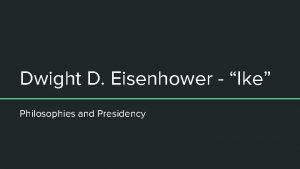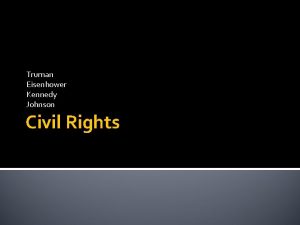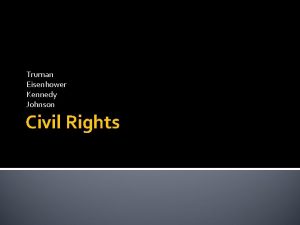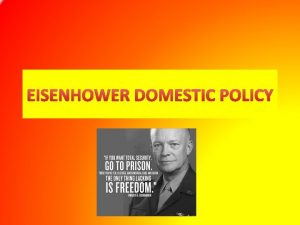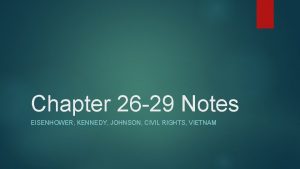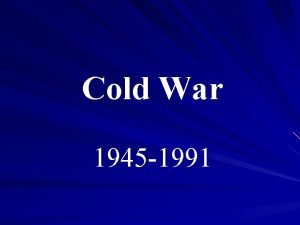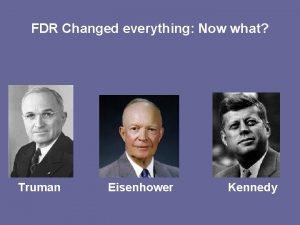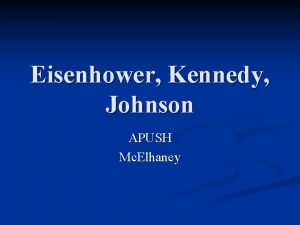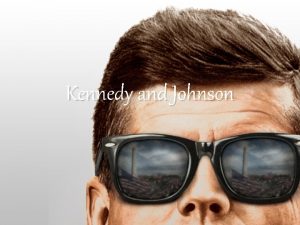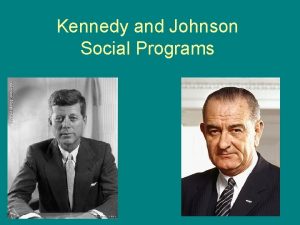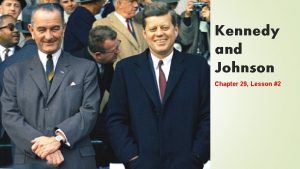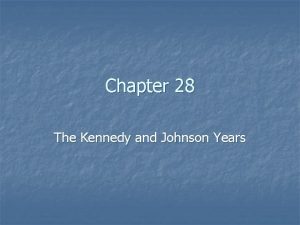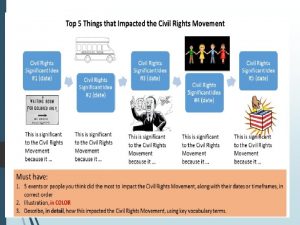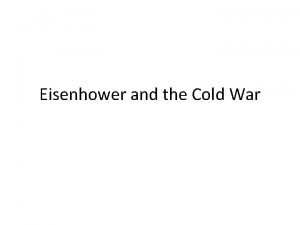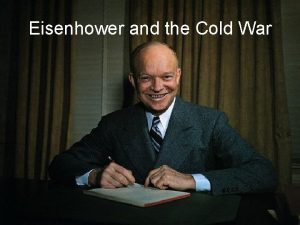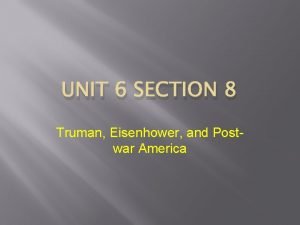Truman Eisenhower Kennedy and Johnson and the Civil























- Slides: 23

Truman, Eisenhower, Kennedy, and Johnson and the Civil Rights Movement

Origins of the Modern Civil Rights Movement: Role of Truman: § Most of his civil rights efforts were blocked by Conservative Democrats in Congress § 1948 – Executive Order 9981 desegregates the military § 1951 – Appoints the first black federal judge William Hastie Above: Truman with Wm Hastie in the US Virgin Islands where Hastie was the Governor from 1946 -49. Hastie received a recess appointment to the US 3 rd Court of Appeals in Oct. 1949. He was confirmed by the Senate in July 1950. He will serve on the Appellate Court for 22 years.

Origins of the Modern Civil Rights Movement: Black Migration: § WWI “Great Migration” § WWII migration to both North & West § After WWII, migration from rural South to southern cities § By 1960, 30% of blacks had left the South. § Significance?

Origins of the Modern Civil Rights Movement: Role of Capitalism: § Post-WWII industrialization in the South = economic opportunities § Emergence of a black middle class § Jim Crow released social tensions that were bad for business & image of the South

Origins of the Modern Civil Rights Movement: The Democratic Party: § Starting in 1936, blacks became an important bloc of the New Deal Coalition § As blacks make the move to the Democrats, southern conservative Democrats begin to leave the party § 1948 Democratic Party platform embraces the cause of Civil Rights From right: Hubert H. Humphrey, Coretta Scott King, and Dr. Martin Luther King

Origins of the Modern Civil Rights Movement: The Cold War: § Global competition with the USSR – especially in the third world – made racism and segregation at home more difficult to export the American version of freedom and democracy abroad § Many Americans believed that the Civil Rights movement was influenced and funded by Labor Unions and communists

Origins of the Modern Civil Rights Movement: The Role of TV: § Influence blacks? § Influence whites? § Used by Civil Rights organizations & leaders?

Desegregating Schools: § NAACP had been working for decades trying to overturn Plessy v. Ferguson § 1954 SCOTUS ruled in Brown v. Board of Education that “separate but equal facilities are inherently unequal” § 1955 SCOTUS followed up with Brown II ordering communities to desegregate their schools “with all deliberate speed”. § “Southern Manifesto” signed by southern members of congress urged defiance to court order § By 1957, only 684 of 3, 000 affected school districts in the South had begun to desegregate NAACP Legal Team that won the Brown case. Thurgood Marshall in center.

Eisenhower & Civil Rights: § While Eisenhower was not an outspoken advocate of civil rights, he did understand the executive’s constitutional role in enforcing the law § Appointed California Governor Earl Warren as Chief Justice of SCOTUS § Some southerners might have taken his silence on civil rights as tacit agreement with their resistance

Montgomery Bus Boycott § § § 1955 Civil Rights activist, Rosa Parks, refused to give up her seat on a bus in Montgomery, AL. She was arrested. The black community in Montgomery organized a boycott of the city’s busses and down town shops that discriminated against blacks. The Montgomery Improvement Association was led by the young Martin Luther King, Jr. On 5 June 1956, the federal district court ruled in Browder v. Gale that bus segregation was unconstitutional, and in November 1956 the U. S. Supreme Court affirmed Browder v. Gayle and struck down laws requiring segregated seating on public buses. The boycott lasted 13 months and demonstrated King’s trademark nonviolent protest techniques.

Showdown in Little Rock § In 1957, white mobs prevented the desegregated Central High School in Little Rock, Arkansas § Gov. Orval Faubus used National Guard to block entry of the first black students to Central High § After a meeting with Eisenhower, Faubus withdrew the troops and the white mobs returned § In response, Eisenhower deployed troops from the 101 st Airborne Division to escort the students to classes for the entire school year § In protest, Faubus closed the public schools the following year to prevent their integration

Civil Rights Act of 1957 • • The Act marked the first occasion since Reconstruction that the federal government undertook significant legislative action to protect civil rights It established the Civil Rights Division in the Justice Department, and empowered federal officials to prosecute individuals that conspired to deny or abridge another citizen’s right to vote. Moreover, it also created a sixmember U. S. Civil Rights Commission charged with investigating allegations of voter infringement. But, perhaps most importantly, the Civil Rights Act of 1957 signaled a growing federal commitment to the cause of civil rights.

Black Youth Stand Up by Sitting Down • Inspired by Dr. King’s proven nonviolent resistance tactics, southern black college students began to defy local segregation laws and customs with “sit-ins”. • On Feb 1, 1960, four black college students in Greensboro, NC, sat down at a Woolworth’s “white’s only” lunch counter, requested service, and politely refused to leave when they were denied it. • April 1960, at Shaw University in NC, the Student Nonviolent Coordinating Committee (SNCC) was formed to organize the growing movement. • By the end of 1961, 75, 000 students, both black and white, were utilizing the sit-in tactic at restaurants and other segregated facilities including: knee-ins at churches, read-ins at libraries, and wade-ins at segregated beaches. Video Clip: Sit In Protest

C. O. R. E. and the Freedom Rides • • Established in 1942 by James Farmer and Bayard Rustin, the Congress on Racial Equality (CORE) was made up of Christian pacifists that worked to find ways to make America live up to the ideals of equality and justice. CORE was dedicated to nonviolent direct action and staged some of the first sit-ins in the North. Many of their tactics were later adopted by other civil rights organizations. In an effort to test the Justice Department’s willingness to protect the rights of blacks to use interstate transportation facilities, CORE organized the Freedom Rides. An interracial group of young civil rights activists attempted to take a series of busses across the South. They were met with violence, beatings, and ultimately, their bus was firebombed in Aniston, AL.

James Meredith & Ole’ Miss • In 1962, James Meredith, a black Air Force veteran, obtained a federal court order to attend the University of Mississippi. • Gov. Ross Barnett personally prevented Meredith from entering the university. • JFK ordered hundreds of US Marshalls to Oxford, MS, to escort Meredith to classes. • Riots broke out on campus. Two people were killed and scores injured. • JFK orders US troops to restore order at the university. The troops remained on campus for the remainder of the school year. • A similar incident was acted out in neighboring Alabama in 1963, where Gov George Wallace stood in the doorway of the University of Alabama to prevent integration.

Mass Demonstrations • • • In May 1963, Dr. King personally led a mass demonstration to desegregate Birmingham, Alabama. The peaceful demonstrations, which included among its ranks thousands of children, were violently countered by the local police led by the notorious “Bull” Connor. Police used water cannons, electric cattle prods, and police dogs against protestors. Dr. King was arrested and put in jail. There he wrote the now classic protest essay, Letter from a Birmingham Jail. Under national pressure (the attacks by the police were captured on TV) city leaders worked out a plan to desegregate the city. However, a few months later, a bomb was thrown at a black church and killed four young girls.

Mass Demonstrations • In June 1963, JFK submitted a civil rights bill to Congress. Conservative southern legislators moved to block the bill. • In an effort to bring attention to the bill and the civil rights movement as a whole, civil rights leaders organized the “March on Washington for Jobs and Freedom”. • Receiving support from service, religious, and labor organizations, more than 200, 000 people took part in one of the largest demonstrations in American history. • The keynote speaker at the event was Dr. Martin Luther King who delivered his famous “I have a Dream” speech.

24 th Amendment • To keep blacks from voting, many southern states had adopted numerous tactics including the poll tax, literacy tests, and property requirements. Ratified in 1964. • Local traditions and threats of violence kept many blacks from the voting booths. • Ratified in 1964, the 24 th Amendment prohibited the use of poll tax as a requirement for voting in federal elections.

The Civil Rights Act of 1964 A master politician, President Johnson pushed the Civil Rights Act of 1964 through Congress despite considerable opposition from southern Conservatives. The Civil Rights Act: • strengthened voting rights protections • prohibited discrimination in places of public accommodation • required the federal govt withdraw financial assistance from any state or local program permitting discrimination in its operation • authorized the Attorney General to initiate law suits to desegregate schools • established the Equal Employment Opportunity Commission (EEOC) to foster compliance with the law forbidding discriminatory practices by employers and labor unions.

Bloody Selma Crucial in the minds of many blacks was the issue concerning voter registration. • The Civil Rights Act forbade election officials to apply standards to black applicants that differed from those applied to white applicants. • Civil Rights leaders decided to use Selma, AL, as a test site for voter registration. (Selma was home to 15, 000 voting age black citizens, but only 300 were registered to vote) • Led by Dr. King, thousands of civil rights activists went to Selma to protest. Mass arrests, beatings, and two killings brought national attention to the cause of voter registration. • In an effort to carry the message to the state capital of Montgomery, a march was planned to begin in Selma. In an notorious act of police brutality (all of which was captured on TV), the marchers were tear gassed, beaten, and trampled by police horses after crossing the Edmund Pettus Bridge. This event is remembered as “Bloody Sunday”. Television Footage •

The Voting Rights Act of 1965 Spurred on by events in Selma, President Johnson addressed Congress in March 1965 and asked the legislators to pass an act that would give the federal government power to ensure nondiscriminatory procedures in all elections. The new Civil Rights Act of 1965: • literacy tests were to be dramatically restricted • federal election monitors would be dispatched to the South to register voters in any county found guilty of disenfranchisement • the attorney general was authorized to bring suits against the use of the poll tax “What’s that big word up there? ”

Militant Blacks The Black Muslims & Malcolm X The Black Muslims, whose organization, the Nation of Islam, was founded in 1930, continued into the 1960 s as a religious body that proclaimed the inherent superiority of the black over the white race and advocated for complete separation of the races. • Although Elijah Muhammad was the revered spiritual leader of the Nation of Islam, the ardent Malcolm X, was the Nation’s leading spokesperson. • Malcolm X advocated self-defense and the use of black violence to counter white violence. • Brother Malcolm was known to speak truth to power in his striving for civil rights. • After discovering corruption within the Nation, Malcolm broke with Muhammad. At the end of his life, after a pilgrimage to Mecca, Malcolm X was softening his tone toward white America. He was assassinated in 1965 by Nation of Islam hit men.

Militant Blacks Black Power: The chairman of SNCC, Stokley Carmichael, gave up on interracial collaboration in the mid-1960 s and decided to move SNCC toward black nationalism and dismissed the organization’s white members. His popular slogan “Black Power” captured the growing frustration with the pace of the civil rights movement and a new willingness to take aggressive action. The Black Panthers: Organized in Oakland, CA, in 1966, by Bobby Seale and Huey Newton, the Panthers advocated a revolutionary socialist movement. Panthers were frequently armed at their events and on at few occasions, engaged in firefights with police.
 Eisenhower and truman compare and contrast
Eisenhower and truman compare and contrast Lesson 1 truman and eisenhower
Lesson 1 truman and eisenhower Lesson 1 truman and eisenhower
Lesson 1 truman and eisenhower Presidential and congressional reconstruction venn diagram
Presidential and congressional reconstruction venn diagram Truman foreign policy vs eisenhower
Truman foreign policy vs eisenhower Truman supports civil rights
Truman supports civil rights Johnson and johnson strengths
Johnson and johnson strengths Johnson and johnson bcg matrix
Johnson and johnson bcg matrix Johnson and johnson organizational structure
Johnson and johnson organizational structure Credo values
Credo values Johnson and johnson botnet infections
Johnson and johnson botnet infections Johnson and johnson swot analysis
Johnson and johnson swot analysis Jjeds johnson
Jjeds johnson Dreikurs classroom management theory
Dreikurs classroom management theory Johnson and johnson md&d
Johnson and johnson md&d Brad and laurie johnson
Brad and laurie johnson Civil rights and civil liberties webquest
Civil rights and civil liberties webquest Open skies apush
Open skies apush Matriz de eisenhower excel
Matriz de eisenhower excel Dwight d eisenhower domestic policy
Dwight d eisenhower domestic policy Lesson 4 eisenhowers cold war policies
Lesson 4 eisenhowers cold war policies Eisenhower philosophy
Eisenhower philosophy Eisenhower
Eisenhower Dwight d eisenhower accomplishments
Dwight d eisenhower accomplishments
